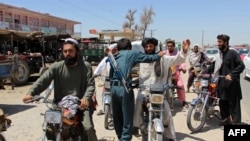LASHKAR GAH, Helmand -- The frustration simmering among an estimated 100,000 residents of a besieged provincial capital in southern Afghanistan has finally bubbled to the surface.
In Lashkar Gah, capital of Helmand Province, hundreds of angry protesting tribal and community leaders called on Kabul to swiftly move to end the nearly four-month Taliban siege of their beleaguered city.
“Oh, the blind and deaf rulers in Kabul, if you have a conscience, come here and deliver Helmand from the calamity we are facing,” community leader Sardar Mohammad Hamdarad told the charged crowd on September 1. “How can they call themselves a government when they cannot protect their women, children, and elderly? Either protect us or tell us not to bother you again.”
Frustration in Lashkar Gah is mounting after government troops failed to permanently reopen the only major highway linking the city to the Kandahar, Afghanistan’s second city some 130 kilometers to the east.
The situation is worsening in a city burdened by thousands of displaced families who have fled the Taliban offensive in Helmand’s rural districts in recent months. According to an Afghan government assessment, the Taliban now control or contest 12 out of Helmand’s 14 districts.
Helmand is Afghanistan’s largest province. Its strategic location on Pakistan’s border, its close proximity to Iran and its status as a hub of opium production and narcotics trade all add to its significance. During the Taliban’s stint in power in the 1990s, Helmand provided a large share of Taliban recruits. All this has turned Helmand into the No. 1 target for an insurgent comeback.
And the result is devastating for its nearly 1 million residents.
“Sangin, Kajaki, Nawa (Nawa-i Barakzai), Nad-e Ali, Gramser, Khannashin, and Greshk districts plus the city of Lashkar Gah are in grave danger,” said one tribal elder, who requested not to be named as he counted the Helmand regions recently overrun by the Taliban or currently in danger of falling to the insurgents. “Lashkar Gah has been under siege because the main road between Helmand’s capital and Kandahar has been cut off for more than 25 days.”
Even local government officials have joined civilians in criticizing the government. Lawmaker Bashir Ahamd Shakir is in charge of the security affairs committee on Helmand’s provincial council. He said Lashkar Gah has turned into one big prison.
“Respected President [Ashraf Ghani], you are treating us as stepchildren by appointing incompetent officials here. You have thrown us into the ditch,” he said. “Our soldiers are being killed daily, and we now control only 5 percent of Helmand’s territory.”
He said mothers from across Afghanistan are receiving the coffins of their sons who served in the Afghan security forces in Helmand. “Isn’t it my right to raise my voice against the rapidly deteriorating situation here?” he asked.
Afghan officials said they have sent reinforcements to Helmand and are trying to push the Taliban back. On August 22, some 100 U.S. troops arrived in Lashkar Gah to assist the Afghan forces.
Abubakar Siddique wrote this story based on Radio Free Afghanistan correspondent Mohammad Ilyas Dayee's reporting from Lashkar Gah, Helmand.








